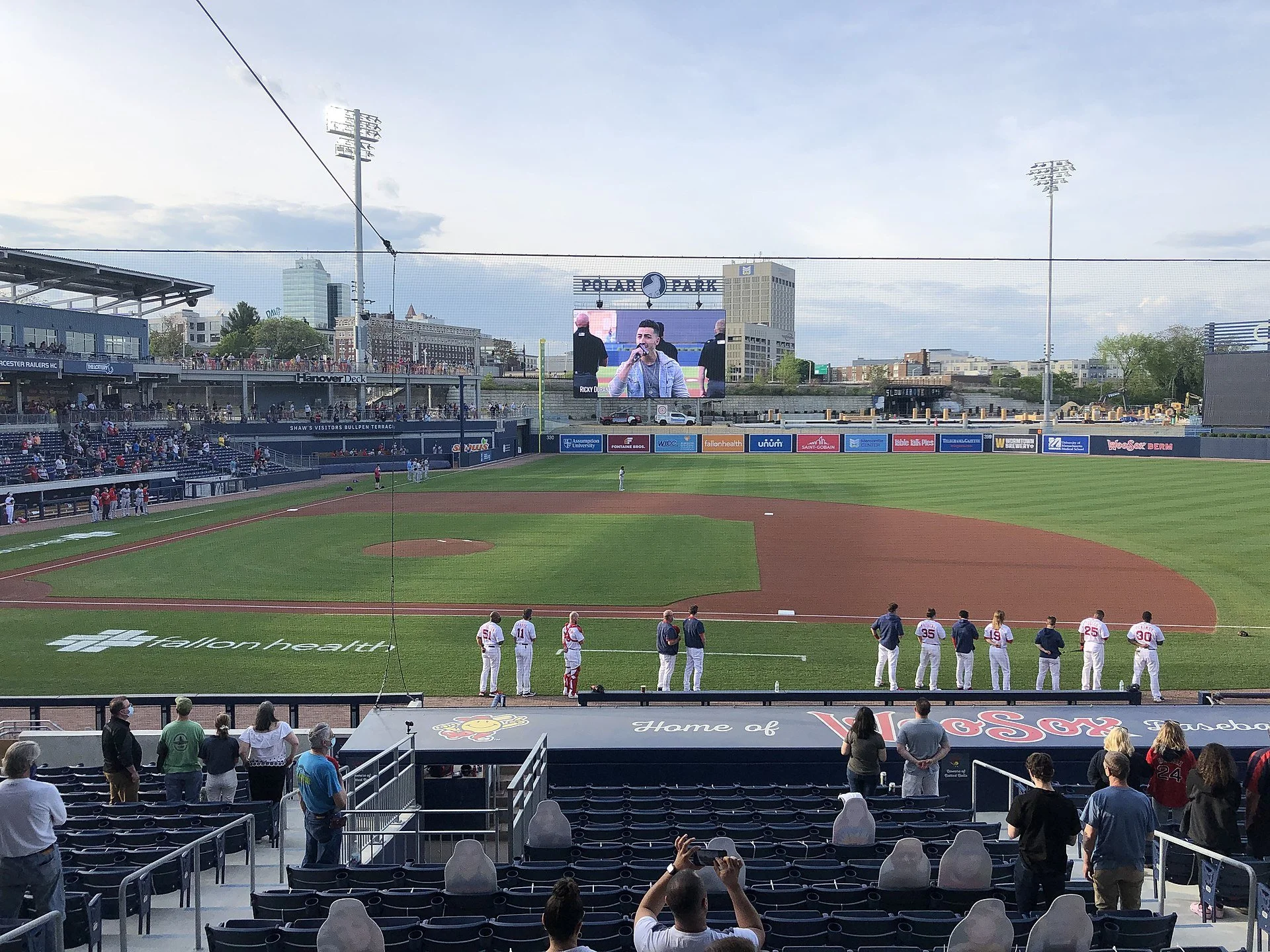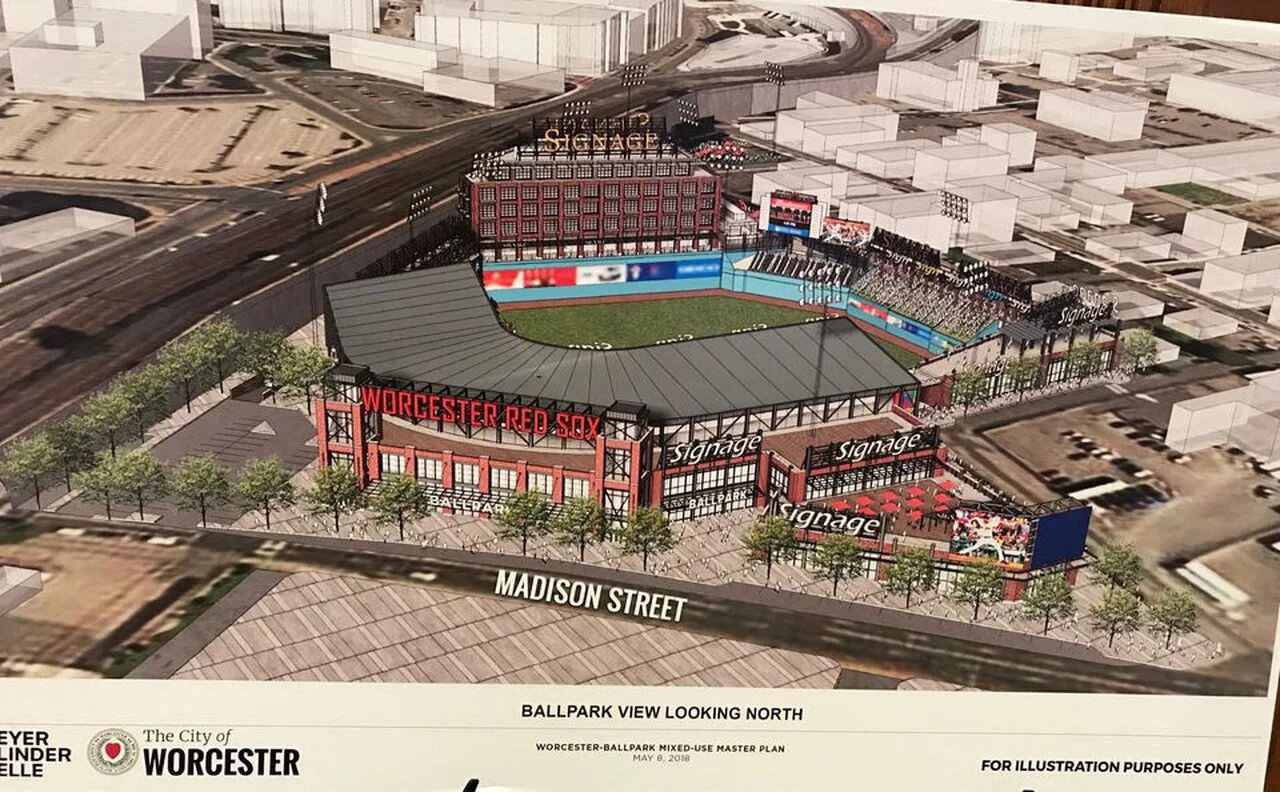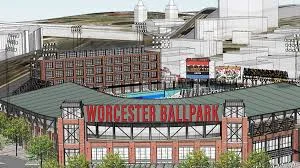
WooSox and summer, etc.
Polar Park, in Worcester
— Photo by MoVaughn123
Adapted from Robert Whitcomb’s “Digital Diary,’’ in GoLocal24.com
On June 11, I drove from Providence to Worcester on Route 146, through old mill towns, to watch the Worcester Red Sox play the Rochester Red Wings at Polar Park. The WooSox won, 5-2, and it was a nice day, with only a little Canadian smoke.
The ballfield is in a gritty and depressing part of the old industrial city, though there’s been some new building in the past couple of years. But I find that looking a few blocks over to the bizarre Union (train) Station’s twin towers, which makes the 1911 structure look like something put up during the Raj, in India, cheers me up, as do the trains running right next to the stadium.
(Don’t feel you have to use the big parking garage next to Polar Park. There’s cheaper and easier surface parking a couple of blocks away.)
The main reason I went to Worcester was to see old friends, who happen to be pals of the WooSox owners. Because of this connection, we watched the game in luxury from a suite with a lounge-like inside area and a porch from which we had a superb view of the field and the stands, though one of my hosts complained that watching a game from a fancy suite at ground level, as was the case with the Pawtucket Red Sox at McCoy Stadium, is more fun. We spent most of our time yakking while sporadically glancing at the action on the field, with cheering the main signal to pay attention.
New professional baseball playing rules, by the way, have blessedly speeded up that action.
There were a little under 9,000 people there -- close to capacity. This is only the stadium’s third year in operation and so probably more than a few in the stands were there out of curiosity to see the glitzy facility. Of course, many baseball fans are still unhappy that this Boston Red Sox affiliate bailed out of Pawtucket. I did see some Rhode Island license plates at Polar Park.
Some economists who are experts in the public financing of such stadiums say that Polar Park will be a long-term drain on the city. Worcester issued $146 million in bonds to build the stadium and owns it. It will take some years to know what the fiscal impact will probably be. The next recession with high unemployment will provide a test; buying a game ticket is, after all, very discretionary. Meanwhile, it has to be said that the WooSox is a very well-run organization.
How much money do WooSox fans from out of town spend in Worcester’s restaurants, etc., outside of Polar Park? Not much, I’d guess. And I doubt that many take in such impressive local cultural venues as the Worcester Art Museum.
Watching baseball, between gossiping with friends and meeting some of their pals for the first time while consuming the likes of lobster rolls or hot dogs (not the latter anymore for me; I avoid eating fellow mammals), popcorn and beer and other goodies is a languid summer pleasure in New England.
As are walking on a beach or along a Vermont stream; letting ice cream and Popsicles drip on your hands; going fishing; eating such vacation artery blockers as fried clams; climbing mountains; sitting on a park bench watching the birds in between desultory looks at a book, and going to country fairs and amusement parks (where you can watch the kids throw up after eating too much candy and then being spun around on a ride).
Summer has certainly changed in our corner of the world in the past five or six decades. One change is the vast expansion of air conditioning. Very few New Englanders had A/C in their homes before around 1970. Movie theaters, restaurants and big stores used to draw many customers simply because they offered cool air.
Summers have generally been getting hotter and longer, and so air conditioning has become increasingly attractive. The tricky thing is that generating the electricity to run the A/C units usually involves burning more fossil fuel, which, in turn, heats up the atmosphere more. Oh, well.
I suspect that home A/C has tended to discourage many people from spending as much time outdoors in the summer as they might have half a century ago – an unhappy change, exacerbated by computer-screen addiction. This probably has played a role in the obesity epidemic. Anyway, we all need more natural light (with sun block on our skin) and exercise. And breezy porches are soothing.
Other notable changes include the building of superhighways to places with great summer allure, most notably in New England -- Cape Cod. This has led to rampant overbuilding there and the erosion of some of the qualities that made The Cape, etc., so beautiful. (I remember the two-way country road with summer farmstands and a piney aroma that led us from Cohasset, Mass., to my grandparents’ house on the Cape in the ‘50s.) And while many folks used to lie for hours in the soporific sunshine, most of us are now aware that we were setting ourselves up for skin cancer.
One improvement is that more people are taking advantage of the fact that summer weather doesn’t end with Labor Day, and can in some years extend into October.
My drive back to Providence from Worcester was thrilling because fewer and fewer drivers these days signal before cutting across lanes. This is particularly menacing in the tangled spaghetti and confusing signage of Worcester’s roads. One guy in an SUV nearly got a bunch of us killed as he swerved across two lanes to get on an exit ramp he belatedly noticed. The best way in and out of Worcester is by helicopter.
May Worcester's big baseball gamble pay off
Rendition of Polar Park
From Robert Whitcomb’s “Digital Diary,’’ in GoLocal24.com
The new, $159.5 million Polar Park project, in Worcester, looks lovely, as well it should at that price. Worcester, through borrowing, is paying $88.2 million, the Worcester Red Sox $60.6 million and the state and Feds $10.7 million, at least according to a Feb. 4 Worcester Business Journal report.
Will Polar Park pay for itself in bigger local business revenues and payrolls and such related public benefits as more municipal-property-tax revenue? Generally, publicly financed sports stadiums don’t pay for themselves, at least in measurable monetary benefits for the taxpayers, though of course they can be very lucrative for the team owners. And there can be psychic benefits for some locals from the pride in having a (hopefully) successful team to rally around and an often jolly place to gather.
In the case of Worcester, I have some doubts on whether, after a year or two of people drawn by curiosity to the new ballpark, the WooSox can lure the number of long-term gamegoers they hope for.
While Worcester was very narrowly the second-largest city in New England in the 2010 Census, with 181,045 people, compared to Providence’s 178,042, its metro area had only 923,672 people, compared to Greater Providence’s 1.6 million. Providence proper’s area is only 20.58 square miles, compared with Worcester’ 38.41.
Those numbers seemingly would have made it much more sensical to keep the Pawtucket Red Sox going, even with less than the substantial taxpayer help that the organization had been offered in the Ocean State. Further, Providence/Pawtucket is on the main street of the East Coast and Worcester is more off to the side.
Well, que sera, sera. Now that Polar Park is up, I wish the WooSox all the best and plan a trip there soon to check it out. While I have little interest in such things as baseball statistics (real baseball fans are obsessed with such data) and don’t much follow the ups-and-downs of current stars, I do love the setting, sights and sounds of baseball: The slope of the stands; the smell of very green grass and of hot dogs and beer; the cheers (and boos); the crack of the ball against the bat; the tacky organ music; the alternations of relative immobility and explosive activity; the manic announcers, and the seventh inning stretch.
As for folks living in and around Worcester, perhaps it will become one of those “third places,’’ such as restaurants, coffee shops, gyms and even some bookstores, where locals go to hang out with their neighbors on a regular basis. We may know within a couple of years. Maybe it will become as beloved a local institution (for many) as Clark University, the College of the Holy Cross, Worcester Polytechnic Institute and the Worcester Museum of Art, and as the PawSox were for so many years in Greater Providence. Maybe.
Big public projects
From Robert Whitcomb’s “Digital Diary,’’ in GoLocal24.com
Publicly funded projects such as that in and around the Worcester Red Sox’s pending Polar Park Stadium, involving a taxpayer commitment of $132 million, up $9.4 million from the previous estimate, tend to create metastasizing tax breaks. Consider that Worcester City Manager Edward Augustus now wants additional tax breaks for private developers in the WooSox district, in this latest case for a 15-year tax break for a building near the ballpark’s left field and for a residential building, and a 10-year tax break for an office, labs and retail complex.
Maybe these projects will indirectly create long-term tax-revenue streams for the city in the form of more economic development and new property-tax revenue nearby -- and maybe not. Depends a lot on how the economic cycle goes in this new decade. In any case, taxpayers should remember that the taxes the developers aren’t paying other taxpayers will have to offset.
All this is part of the vision for a total of $125 million in private development next to Polar Park.
Stadium-construction projects usually turn out well for rich team owners and associated developers, but generally not – at least economically -- for the general taxpaying public. That isn’t to say that having a baseball team in town won’t make plenty of people feel better, at least for a while, especially if the team wins more than it loses and spawns stars that head for the Major Leagues.]
For more information, please hit these links:
https://www.wbjournal.com/article/worcester-seeking-more-tax-breaks-for-woosox-related-development
https://www.golocalprov.com/news/leading-stadium-expert-blasts-worcester-for-polar-park-cost-overruns
xxx
Field house and pump station built by the New Deal’s Works Progress Administration in Scituate, Mass., in 1938
But public projects can be immensely useful and profitable for the general public. Consider the bridges, roads, tunnels schools, post offices, parks, etc., built in the New Deal – a lot of them still serving the public. They were, in general, very well built. But America’s public infrastructure has been falling apart for decades, damaging our quality of life and making America less economically competitive. When he was running for president, Trump promised to start rebuilding our infrastructure. Instead, he pushed for big tax cuts for the rich.
A presidential candidate who can credibly promise to lead that rebuilding, with many well-paying jobs included, would have a very strong issue in this year’s election.
Woosox's Polar Park as high-tech center
From Robert Whitcomb’s “Digital Diary,’’ in GoLocal24.com
I predict that after a couple of years of curiosity and excitement, attendance will fall at Polar Park, the new baseball stadium to be built as the home of what is now (sigh) called the Pawtucket Red Sox. Polar Park (after Worcester-based Polar Beverages) is supposed to open in 2021. Eventually there may be considerable loyal buyers’ remorse for the big tax breaks and other publicly financed incentives being given to the group of very rich men who are moving the team. And how popular will baseball in general be in a decade? Whatever, I wish them well.
Anyway, however the Boston Red Sox farm team does in Worcester, something of long-term value may come out of the project:
Worcester Polytechnic Institute and the PawSox will partner to improve ballpark technology. This will include having WPI students working on such projects as mobile apps for ordering food, technology to ease parking and special seating for those with sensory challenges.
WPI’s president, Laurie Leshin, said: “As Worcester’s hometown technological university, WPI shares the club’s vision and opportunity for Polar Park: to create a versatile regional sports venue that combines a traditional ballpark environment with modern, smart, and connect amenities.”
So however successful the park turns out to be as a business, technological applications, some of them utterly unanticipated, might come out of the park that can be used to improve things at other large entertainment venues. Think of the surprising electronics and medical advances that came out of the U.S. space program in the ‘60s.
Advancing ballpark tech in Worcester
Rendering of Polar Park.
From The New England Council (newenglandcouncil.com):
Worcester Polytechnic Institute (WPI) and the Pawtucket Red Sox have announced a partnership to advance ballpark technology once the team moves to Worcester, in 2021. This partnership will provide the new Polar Park in Worcester with the latest technology.
WPI students will work on projects to modernize the game experience, such as mobile apps for ordering food, technology to assist with finding parking, or special seating for those with sensory challenges. The partnership will also make the school the team’s official academic technology advisor through the 2023 baseball season.
The president of WPI, Laurie Leshin, commented, “As Worcester’s hometown technological university, WPI shares the club’s vision and opportunity for Polar Park: to create a versatile regional sports venue that combines a traditional ballpark environment with modern, smart, and connect amenities.”
Larry Lucchino, principal owner and chairman of the Pawtucket Red Sox, said, “One of the many appealing assets in Worcester is WPI, a world-class technology leader. . . We have long sought this collaboration to help this ballpark be innovative as well as friendly and beautiful. We look forward to WPI’s participation on the key technology fronts.’








